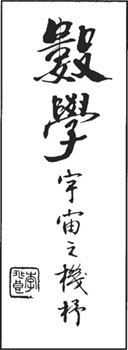Notes to the Paperback Edition

Notes to the Paperback Edition |
|
I am delighted that Sterling Publishing has invited me to prepare the new paperback edition of The Loom of God. Indeed both public and scientific fascination in subjects relating to God religion, mathematics, mysticism, and Doomsday seem to be growing, as indicated by the explosion of works ranging from the popular Left Behind series of apocalyptic novels and The Da Vinci Code to the recent movie version of I Am Legend.
Apocalyptic thinking about the End of Days for humanity is increasingly on our minds as we ponder the ramifications of catastrophic climate change, nuclear proliferation, and the likelihood of asteroid or comet impacts with Earth. Another form of the End of Days is the so-called technological singularity for which some futurists predict technological progress so astonishingly rapid that artificial intelligences will surpass us as the smartest and most capable life forms on Earth. Even the most serious cosmologists now ponder the ultimate fate of the universe. For example, if the acceleration of the universe continues as a result of a dark energy that seems to pervade our cosmos, this dark energy may eventually exterminate the universe in a “Big Rip” as all matter is torn apart.
With the year 2012 fast approaching, authors and publishers appear to be starting a countdown to another form of potential Doomsday apocalypse with a slew of books that predict calamity, spiritual transformation, or other momentous change in 2012—the year that a Mayan calendar cycle is completed. The Mayan Long Count calendar spans more than 5000 years, then resets to year zero in 2012. Depending on the author, we find any of the following are predicted to happen: an asteroid will collide with Earth, supervolcanoes erupt, the Earth’s magnetic field reverses, or a mysterious global connection occurs with the emergence of a transhuman consciousness formed from the interactions of multiple human minds.
Our brains may be wired for belief in God or unseen entities. Religion is at the edge of the known and the unknown, poised on the fractal boundaries of psychology, history, philosophy, biology, and many other scientific disciplines. Because of this, the topics in The Loom of God are important subjects for contemplation. Even with the great scientific strides we will make in this century, we will nevertheless continue to swim in a sea of mystery. Humans need to make sense of the world and will surely continue to use both logic and religious thinking for that task. What patterns and connections will we see as the twenty-first century progresses? Who or what will be our God?
In closing, I would like to update readers on certain terms and concepts discussed in this book. Due to incredible advances in computing power, at least one numerical world record in this book has recently been broken. For example, as of 2008, the largest known perfect number (a concept discussed in Chapter 7) 232,582,656 × 232,582,657 – 1, with an amazing 19,616,714 digits.
As I mention in Chapter 14, the ancient Incas used quipus (pronounced “key-poos”), memory banks made of strings and knots, for storing numbers. Until recently, the oldest-known quipus dated from about 650 A.D. However, in 2005, a quipu from the Peruvian coastal city of Caral was dated to about 5000 years ago.
In Chapter 16, I mention that one of the world’s fastest computers performs scientific calculations at a rate of around one teraflops—that is, one trillion floating point operations per second. In 2008, the fastest supercomputers achieve performances of over 1000 teraflops.
Chapter 21 discusses the infamous 1908 Tunguska explosion, which mysteriously leveled a very large area of Siberian forest. Supercomputer simulations performed in 2007 suggest that such devastation may have been caused by an impacting asteroid far smaller than previously thought, due to the asteroid’s likely creation of a supersonic jet of expanding superheated gas. This finding suggests that any defensive strategy that we may develop to ward off asteroid impacts may need to consider the dangers of even smaller-sized menaces.
Although I did indeed “coin” the word theomatics with its particular meaning for use in this book, this word has been employed before my use. Prior use of this term often involved the numerological study of the Greek and Hebrew texts of the Christian Bible.
A great deal of this book focuses on Pythagoras, the ancient Greek mathematician and philosopher who is often credited with the invention of the Pythagorean theorem. However, evidence suggests that the theorem was developed by the Hindu mathematician Baud-hayana centuries earlier, around 800 B.C., in his book Baudhayana Sulba Sutra. Pythagorean triangles were probably known even earlier to the Babylonians. Although the famous theorem that bears Pythagoras’ name, a2 + b2 = c2 for a right triangle with legs a and b and hypotenuse c, was probably known much earlier than the days of Pythagoras, some scholars have suggested that Pythagoras or his students were among the first Greeks to prove it.
For the latest reader comments, corrections, updates, and suggestions—including those with respect to the program code at the back of this book—please visit my new website: www.pickover.com/loom.html. As you peruse this book, I hope you will feel the sense of adventure I had when exploring all of the diverse subjects.